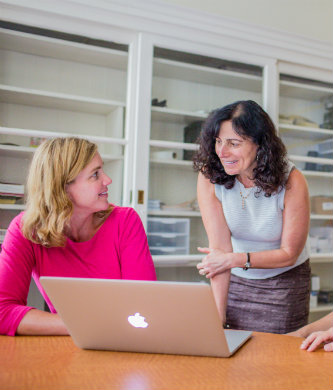Building relationships, breaking stereotypes
The first time a teacher and parent meet one-on-one is often under stress-inducing circumstances: in a parent-teacher conference where a child’s school performance is being evaluated or when a student is facing discipline.
Those instances can start teachers and parents off on poor footing. Such interactions can be especially strained if teachers and parents harbor stereotypes about each other, as is sometimes the case with teachers who speak only English working with Latino parents who are Spanish-speaking and whose children are dual language learners (DLL).
To break down those barriers, L. Brook Sawyer, assistant professor of teaching, learning and technology, and Patricia Manz, associate professor and program director of school psychology, set up a program called Project TAPP (Teachers and Parents as Partners). Sawyer and Manz, along with school psychology graduate student Kristin Martin, collaborated with parents and teachers from four early childhood centers in the Lehigh Valley that serve a large Spanish-speaking population to understand and address the barriers specific to DLL children.
A community of practice
In the fall of 2013, the professors met with 14 parents in small focus groups and with separate focus groups of 17 teachers to learn what parents and teachers believe about how children learn a second language, the roles of teachers and parents in supporting children’s language development, and how parents and teachers can collaborate to provide strong language environments for dual language learners. Following these discussions, Sawyer and Manz formed a community of practice in one early childhood center that included three teachers and two parents. In the spring of 2014, the community of practice involved several routine meetings and trials of strategies for facilitating the language development of DLL children.
“Patti [Manz] and I have always been really interested in supporting families and teachers of children who have less than optimal trajectories once they hit school,” says Sawyer. “So that can be a variety of children: children with disabilities, children who are living in poverty, dual language learners. There’s not a lot of literature about dual language learners, especially in the preschool years.”
Preschool teachers who only speak English might not have the training and strategies to work with dual language learners, which can lead to frustration for the teachers, children and parents.
“The parents may not seem to be as involved because they may not speak English very well or they may have had a poor schooling experience themselves, and they are working a lot so those parents might not be as visible to the teachers as other parents,” says Sawyer. “So teachers can often have a pretty negative view of dual language learners and their families.”
Sawyer and Manz found that most documented attempts to improve educational experiences for dual language learners focused only on teachers or only on parents. Using a $24,056 internal faculty grant, they embarked on Project TAPP as a way to bring parents and teachers together to learn from each other on how to better educate the children.
“What we wanted to do was figure out a way to bring out the strengths of these families and make teachers aware that they bring all these strengths,” says Sawyer. “How can we do that in a way that supports the teacher so that it makes it easier for teachers to bring children’s culture and language into the classroom?”
So, for example, Sawyer and Manz videotaped each parent in the community of practice reading aloud a children’s book in Spanish. Their child’s teacher would then show the video during the preschool class before reading the same book in English to the class.
The exercise had the effect of helping the dual language learners understand the story better and gave the children an opportunity to see their parents’ Spanish language skills in a positive light.
“The kids got so excited, and they would say, as they did with one little boy: ‘That’s your mom!’” says Sawyer. “Then that child felt special that his family had something to offer to the classroom.”
A stronger partnership
In another exercise, Sawyer and Manz had the two parents translate into Spanish some common phrases teachers might use and taught them to teachers. “When the teachers used even a little bit of Spanish in talking to children, they discovered more of their students spoke Spanish than they originally thought,” says Manz.
“Already these children are aware that they are in a minority culture, at some level,” says Manz. “So if they speak Spanish, they may feel it will set them apart even more.”
The professors found that the increase of communication between the parents and teachers improved relationships and in some cases, dispelled stereotypes.
At the end of the project, two teachers told Sawyer that they entered the experiment with negative views of Hispanic families and the meetings and activities changed that. One teacher who had grown up in a family with a lot of racial bias became so close to one of the Spanish-speaking parents that they would hug when the mom would drop off her daughter at school.
A parent from Puerto Rico said that it was the first time since she lived in the United States Mainland that her ability to speak Spanish had been valued.
Sawyer and Manz have submitted two peer-reviewed publications that are currently under review. In a future study they would like to try to collect data on whether developing parent-teacher collaborations promote dual language learners’ language development. But the project’s immediate value was clear: Parents who had been largely invisible at the early childhood centers felt more comfortable conversing with teachers about their children’s education, which in turn altered teachers’ assumptions about the families.
“You see them start to talk and exchange ideas as two equal partners,” says Manz.
Story by Margie Peterson
Photo by Christa Neu
Posted on:





